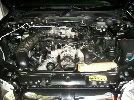raistlin wrote:Tis definitely concrete chaps.
What is SDS please Andy?
SDS hammer drills were introduced to the market in 1975 by Bosch. SDS stands for Special Direct System. They are similar to normal hammer drills, but have an improved hammer action that allows more powerful hammer blows. You will also need SDS drill bits that are specifically designed for SDS hammer drills, these improve safety by reducing slips, and are more robust than regular bits.
Normal hammer drills need to move the whole drill chuck to apply the hammer action. An SDS drill will allow the bit to move inside the chuck, allowing power to be directed more accurately and efficiently, which results in better performance drilling through substances such as concrete.
What are the benefits of an SDS drill over a normal Hammer Drill?
Drilling hard masonry, concrete and bricks are where the SDS hammer drill excels over normal hammer drills, drilling through substances up to 90% quicker than conventional hammer drills. If you carryout these sorts of tasks regularly throughout the day, it is obvious how much quicker you will be able to complete your work with an SDS drill.
Drilling modes
Drill Only
Normal drill without hammer action, maximum speed is typically slower at 1500RPM, and torque is higher than normal drills.
Hammer Only
Also called “roto stopâ€Â. You can fit a range of SDS chisel bits and use the drill like a micro concrete breaker. Ideal for light demolition, removing tiles, bricks, and creating socket cut ins or cable runs. Not all products will have this mode.
Drill and Hammer
Drill mode with the hammer action. SDS hammer drills can be quieter than conventional SDS hammer drills, despite the extra performance.
Beneficial Features
Safety clutches improve safety by cutting the power to the drill bit if jams in the substance being drilled. Without this, if the bit does jam, the drill could spin out of your grip and cause harm to your wrist/arm, knock you off a ladder, damage the substance or hurt bystanders. Mid range drills and up will have this feature, it is highly recommended.
2kg is an ideal weight for a drill that is used regularly. 4kg+ drills will be ok if you only use them occasionally, but long periods of use will be harder to work with. Low end budget drills tend to be heavier.
Decent speed control will allow you to be more careful entering and exiting substances.
Rotation lock allows you to lock the rotation of the drill, so that if you want to chisel into substances, it will not rotate. This is essential if you want to use the drill in hammer mode to chisel accurately.
Note
Because of the increased power you will have using an SDS hammer drill, be careful when drilling as you could remove large sections of the wall when the SDS drill hammers its way out. Drilling small pilot holes and taking care would solve this.
SDS drills will give the maximum drill bit diameter in the title, such as 1 Inch, or 1 1/8 inch. Bigger drill bit diameters will fit, but will be underpowered.



 A car forum that also happens to be a drill forum
A car forum that also happens to be a drill forum 
